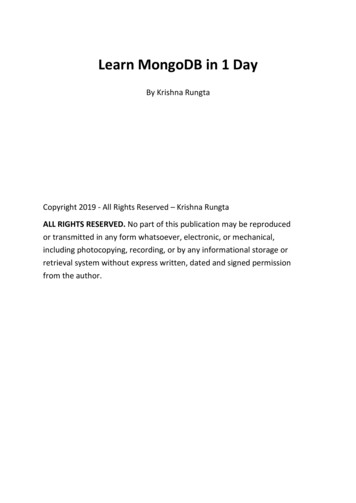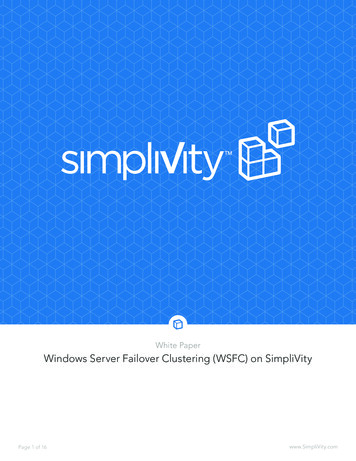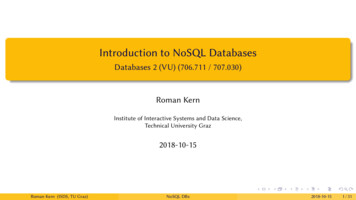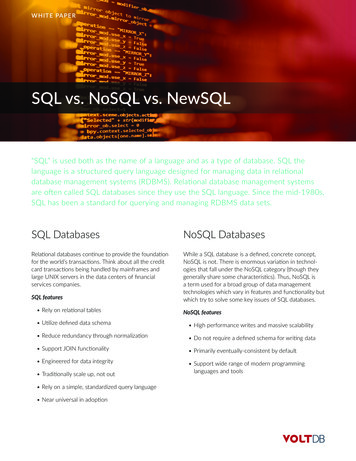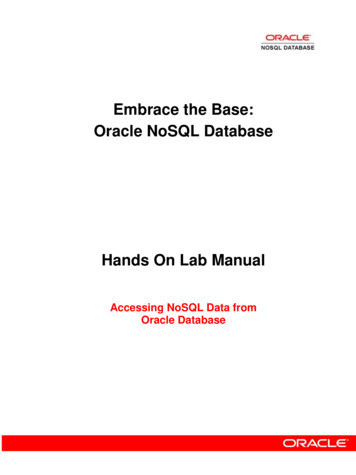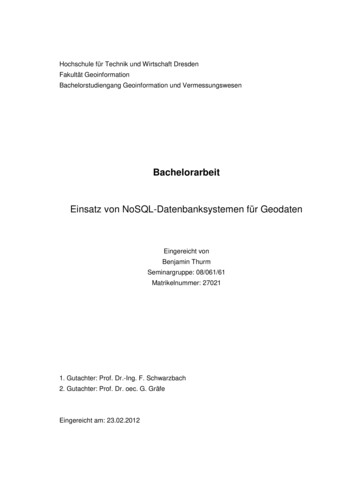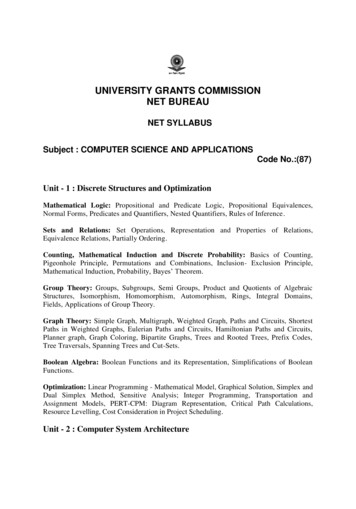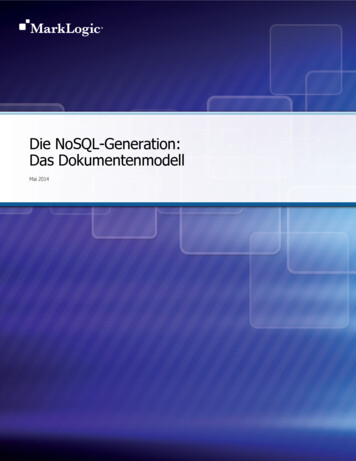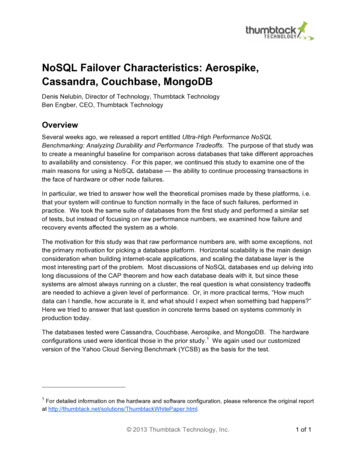
Transcription
NoSQL Failover Characteristics: Aerospike,Cassandra, Couchbase, MongoDBDenis Nelubin, Director of Technology, Thumbtack TechnologyBen Engber, CEO, Thumbtack TechnologyOverviewSeveral weeks ago, we released a report entitled Ultra-High Performance NoSQLBenchmarking: Analyzing Durability and Performance Tradeoffs. The purpose of that study wasto create a meaningful baseline for comparison across databases that take different approachesto availability and consistency. For this paper, we continued this study to examine one of themain reasons for using a NoSQL database — the ability to continue processing transactions inthe face of hardware or other node failures.In particular, we tried to answer how well the theoretical promises made by these platforms, i.e.that your system will continue to function normally in the face of such failures, performed inpractice. We took the same suite of databases from the first study and performed a similar setof tests, but instead of focusing on raw performance numbers, we examined how failure andrecovery events affected the system as a whole.The motivation for this study was that raw performance numbers are, with some exceptions, notthe primary motivation for picking a database platform. Horizontal scalability is the main designconsideration when building internet-scale applications, and scaling the database layer is themost interesting part of the problem. Most discussions of NoSQL databases end up delving intolong discussions of the CAP theorem and how each database deals with it, but since thesesystems are almost always running on a cluster, the real question is what consistency tradeoffsare needed to achieve a given level of performance. Or, in more practical terms, “How muchdata can I handle, how accurate is it, and what should I expect when something bad happens?”Here we tried to answer that last question in concrete terms based on systems commonly inproduction today.The databases tested were Cassandra, Couchbase, Aerospike, and MongoDB. The hardwareconfigurations used were identical those in the prior study.1 We again used our customizedversion of the Yahoo Cloud Serving Benchmark (YCSB) as the basis for the test.1For detailed information on the hardware and software configuration, please reference the original reportat .html. 2013 Thumbtack Technology, Inc.1 of 1
Test DescriptionThe general approach to performing the tests was to bring each of these databases to a steadystate of transactional load. We then brought one of the cluster nodes down in an unfriendlyfashion and monitored the effects on latency and throughput, and how long it took for thedatabase to once again hit a stable state. After 10 minutes of downtime, we would bring a nodeback into the cluster and perform system-specific recovery tasks. We then monitored the effecton performance and availability over the next 20 minutes.We first ran this test at 50% of each database’s maximum throughput (as measured in the priorstudy.) Given our four-node cluster, this ensured that even with one node down there wasplenty of capacity to spare. An absolutely perfect system should show instantaneous failoverand no impact whatsoever from node failures or recovery. In reality, of course, the failure needsto be detected, traffic rerouted, and ultimately data needs to be rereplicated when the node isreintroduced. Ideally, the database should strive for as close to zero impact as possible whilesupporting these features.We also ran the same tests at 75% and 100% throughput on the cluster. At 75%, in theorythere would be sufficient capacity to run even with one of the four nodes down, but with zeroroom to spare. This scenario represented an organization that invested in the minimal amountof hardware to support a one node loss. The 100% scenario represented the worst casescenario of a node failing when at capacity. We would expect performance to fall by at least25% when we removed one of the nodes.Other attributes we varied for the test were:Replication Model:Both synchronous and asynchronous replicationDurability Model:Working set in RAM or written directly to diskWorkload:Both read heavy and balanced workloadsFailure Type:Simulated hardware failure versus network split brain2In the interests of clarity, we did not include all the data we collected in our analysis. Many ofthe variables had little effect on the overall picture, other than changing the raw numbers inways already discussed in the prior report.The replication model did cause significant changes in how the cluster behaved under stress.We ran synchronous replication scenarios for Aerospike, Cassandra, and MongoDB, but wereunable to get this to function for Couchbase. However, given our cluster size and the wayCassandra and MongoDB handle node failures, these databases were unable to perform2kill -9, forced network failures, hardware power down, and other methods were tried and showedsimilar behavior. We opted to use kill -9 as the baseline. 2013 Thumbtack Technology, Inc.2 of 2
transactions while a node was down. This would not be true when using a larger replicationfactor, but was a necessary limitation to keep these results in the same baseline as our lastreport.Client & Workload DescriptionAs mentioned above, we ran the tests using two scenarios to represent different consistencylevels of desired. The weak consistency scenario involved a data set that could fit entirely intoRAM and was asynchronously replicated to a single replica. This was the classic eventuallyconsistent model, and we expected it to provide the best results when dealing with nodefailures. The strong consistency scenario relied on synchronous replication, and used a largerdata set.Although we ran a broad swath of tests, we simplified the reporting of results for the sake ofclarity. The baseline workload is described below.Data Sets and WorkloadsWe used the same data sets and workloads as in the prior tests. To rehash:Data SetsRecord description:Record size:Key description:Key size:# of records (strong scenario):# of records (weak scenario):Each record consisted of 10 string fields, each 10 byteslong and with a 2-byte name120 bytesThe key is the word “user” followed by a 64-bit FowlerNoll-Vo hash3 (in decimal notation)23 bytes200,000,00050,000,000WorkloadYCSB Distribution:Balanced:Zipfian50% reads / 50% writesWe ran each test for 10 minutes to bring the database to a steady state, then took a node down,kept it down for 10 minutes, and then continued to run the test for an additional 20 minutes toexamine recovery properties.3http://en.wikipedia.org/wiki/Fowler Noll Vo hash 2013 Thumbtack Technology, Inc.3 of 3
Overview of Failover BehaviorsAs with all measurements, the durability and consistency settings on the database haveperformance and reliability tradeoffs. The chart below shows some of the implications of thedatabases we tested and how they would typically be nc)StandardReplication ronousDefault sync batch 128kB per device immediate10 seconds10 seconds250k records100 msMaximum writethroughput 00 rowsnonelargeConsistency model ate*Consistency onInconsistentsingle node tInconsistentAvailability onAvailablesingle node failure /no bleData loss on replica 25%9set failure25%25%25%25%50%230,000Possible data loss largeon temporary nodefailure57862400 rowsAll of these databases can be configured with other durability properties, for example MongoDBand Couchbase can be configured not to return success until data has been written to disk4With these settings (from prior report with balanced workload)Synchronous disk writes were about 95,000 writes per second, so under high load much of thedatabase could be stale6Disk IO was measured at about 40,000 writes per second, so under high load much of the databasecould be stale7Couchbase and MongoDB both offer immediate consistency by routing all requests to a master node.8In our cluster. Technically, this should be written as “Availability when quorum not possible”, as itdepends on the replication factor being used. With a replication factor of 3 or 4 instead of our 2, thesystem would be available when 1 replica is down but unavailable when 2 replicas are down.9By “Data loss on replica set failure”, we mean the loss of the number of nodes equal to the replicationfactor. For MongoDB, this would mean losing all the nodes in a replica set.5 2013 Thumbtack Technology, Inc.4 of 4
and/or replicated, but we choose the ones that worked well in our testing and would be used inmost production environments.ResultsTrying to quantify what happens during failover is complex and context-dependent, so beforepresenting the raw numbers, we give an overview of what happens during failover for each ofthese systems. We then present graphs of the databases performance over time in the face ofcluster failures, and then attempt to quantify some of the behaviors we witnessed.For clarity, in this section we primarily show the behaviors for databases operating with aworking set that fits into RAM. We also tested with a larger data set that went to disk. Thoseresults were slower but similar in content, though with more noise that makes reading some ofthe graphs difficult. We felt the RAM dataset is better for illustrating the failover behavior 00%100%Downtime(ms)3,2001,6006,300 toreto100%throughput* Assuming perfect monitoring scripts10Our earlier report provides a detailed explanation of how these databases perform with a disk-baseddata set, for those who are interested. 2013 Thumbtack Technology, Inc.5 of 5
Cluster Behavior Over TimeBelow are some graphs that represent how the databases behaved over the full course of thecluster disruption and recovery. For the sake of clarity, we do not show every test scenario, butmerely some representative cases that illustrate the behavior we saw.Interpreting performance over timeThe graphs below illustrate different behaviors of the databases through the lifecycles of somerepresentative tests.The applications behaved similarly under the default case of 75% throughput usingasynchronous replication and a RAM-based data set. In all the cases, there was a brief periodof cluster downtime when a node went down, followed by continued throughput at or near theoriginal level. When the node rejoined the cluster, there was another brief period of downtimefollowed by a throughput quickly being restored to the original level. The main differencebetween databases was the level of volatility in latencies during major events. Aerospikemaintained the most consistent performance throughout. Cassandra showed increasedfluctuations while the node was down, and MongoDB became significantly more volatile as thenode rejoined the cluster. Couchbase had the peculiar characteristic of decreased volatilitywhile the node was down, presumably because of reduced replication.Under 100% throughput, Aerospike, Cassandra, and Couchbase each saw capacity drop by25% when a node went down, exactly as one would expect when losing one of four machines.MongoDB showed no change; again this is what is expected given their replica set topology (thenumber of nodes servicing requests is unchanged when a slave takes over for the downedmaster.) When the node was brought back and rejoined the cluster, all the databasesrecovered to near full throughput, though Couchbase took some time to do so. (In the picturebelow, Cassandra throughput did not recover, but this is an artifact of the client driver’sreconnect settings and does not represent database behavior.)When running the tests with synchronous replication and using disk-based persistence, someinteresting trends are visible. Given a replication factor of 2, only Aerospike was able to keepservicing synchronous requests on a node down event — it simply chose a new node for writingreplicas on incoming write operations. Both Cassandra and MongoDB simply failed for updatesthat would have involved the missing replica. This resulted in downtime for the duration of thenode down event, but a rapid recovery to full capacity as soon as the missing node becameactive again.11 A corollary for Aerospike is that there is substantial replication effect when thenode comes back and more current data is migrated to it, which can easily be seen in the graph.As in our prior tests, we were unable to get Couchbase to function in a purely synchronousmanner.11If the replication factor were three, the writes should succeed. A more complete accounting of this willbe presented in a future report. 2013 Thumbtack Technology, Inc.6 of 6
75% load, asynchronous replication, RAM-based data setFigure 1a: AerospikeFigure 1b: CassandraFigure 1c: CouchbaseFigure 1d: MongoDB 2013 Thumbtack Technology, Inc.7 of 7
100% load, asynchronous replication, RAM-based data setFigure 2a: AerospikeFigure 2b: CassandraFigure 2c: CouchbaseFigure 2d: MongoDB 2013 Thumbtack Technology, Inc.8 of 8
75% load, synchronous replication, SSD-based data setFigure 3a: AerospikeFigure 3b: CassandraFigure 3c: Couchbase (N/A)Figure 3d: MongoDB 2013 Thumbtack Technology, Inc.9 of 9
Node Down BehaviorWe measured how long it takes for the database cluster to become responsive again (which wedefined as handling at least 10% of prior throughput) during a node down event. For this test,the databases were running in an asynchronous mode. We examined the amount of time thecluster was unavailable and the subsequent effect on performance with the node down.All the databases performed quite well in this scenario. MongoDB, Couchbase, and Aerospikeall became available within 5 seconds of the event, while Cassandra took up to 20 secondsunder load. In the case of both MongoDB and Couchbase, the recovery time was close toimmediate (but see note below).Figure 4a: Downtime, asynchronous replication, RAM-based data maxthroughput12We do not include a graph of downtime in synchronous mode. As discussed earlier, Cassandra will notfunction in synchronous mode with a replication factor of 2 (though it will with larger replication factors),and Couchbase and MongoDB are not designed with synchronous replication in mind. For Aerospike,synchronous replication worked as advertised and had similar downtime numbers. 2013 Thumbtack Technology, Inc.10 of 10
Figure 4b: Downtime, variability by aseMongoDBSome caveats should be made in interpreting these results. First of all, we use a manualfailover for Couchbase. Couchbase’s auto-failover has a minimum value of 30 seconds, andwhen using it we saw downtimes of 30-45 seconds. In contrast to the other products tested,Couchbase recommends doing independent monitoring and failover of the cluster, and so weassumed a near-perfect system that detected failures within 1 second. In reality, it would not berealistic to assume a true failure based on one second of inactivity. What we can concludefrom this test is that when using outside monitoring, Couchbase can recover quickly if themonitors and recovery scripts are reliable.In short, we felt all of these products performed admirably in the face of node failures, given thatthe frequency of such events are quite small, and all the times listed here are probably withinthe level of noise in monitoring the system in general. 2013 Thumbtack Technology, Inc.11 of 11
Figure 5: Relative speed on node down (asynchronous replication, RAM-based data 5%ofmaxthroughputunlimitedthroughputOnce the cluster becomes available after a failure, the performance remained unaffected for the50% and 75% scenarios, exactly as we expected. For the 100% load scenario, theperformance degraded to approximately 75% as expected, with the exception of MongoDB,which continued to perform at full speed since the formerly unused secondary nodes kicked into continue performance. (In some tests, the speed actually increased, which we chalked up tothe fact that replication overhead was no longer needed.)Before the failure, latency for all the systems is extremely low, but after the node fails all thesystems slow down considerably.Node Recovery ResultsIn general, restoring a cluster is a more expensive operation than losing a node, since thedatabase must first detect and resolve any conflicting updates and then replicate over any dataon the new node that might be stale. In our tests, all the databases were able to perform thisoperation quite well with little downtime or impact on throughput. 2013 Thumbtack Technology, Inc.12 of 12
Figure 6: Downtime during node join (asynchronous replication, RAM-based data ofmaxthroughputAll the databases started servicing requests almost immediately, except for MongoDB whichhad about 30 seconds of downtime when rejoining the cluster.Figure 7: Relative performance after node joins (asynchronous replication, RAM-based data oughput75%ofmaxthroughputunlimitedthroughputAs is clear from the 100% load scenario, throughput on the systems did not recover immediatelyonce the cluster is repaired (in the case of MongoDB, since the throughput never dropped, it didnot need to recover.) Once the new nodes were brought to a fully consistent state through 2013 Thumbtack Technology, Inc.13 of 13
replication, performance recovered completely. The length of time it took for this replication tocomplete is not a fair metric, since the amount of data being pushed through the systems varieddramatically by database. We can say that for all databases, throughput eventually recoveredto starting values.ConclusionsThe central conclusion we made is that these products tend to perform failover and recovery asexpected, with varying levels of performance fluctuations during the tests. Even under heavywrite load, the interruptions in service were limited to 30 seconds or less. This was repeated innumerous tests, using different methods of disrupting the cluster, and using different kinds ofworkloads, storage models, and replication settings. The truth is that all these databasesperformed were able to detect and automatically handle failure conditions and resume servingrequests quickly enough to not make this the primary concern.The behavior of the databases as they handle the conditions is interesting. Of the fourdatabases we tested, only Aerospike was able to function in synchronous mode with areplication factor of two. With a larger cluster and larger replication factor this is no longer true.However, it is a significant advantage that Aerospike is able to function reliably on a smalleramount of hardware while still maintaining true consistency.As discussed in the beginning of our results section, one of the major disadvantages in runningin asynchronous mode is the potential for data loss on node outages. This can mean datainconsistency in the case of a transient failure such as a network outage, or complete data lossin the case of of a disk failure. Attempting to quantify this in a reproducible way was quitedifficult, and the tradeoff between performance and replication speed is tunable on some ofthese systems. We did offer a theoretical amount of data loss based on the ways thesedatabases sync to disk.During our tests we did discover some bugs in some of the products, all of which were fairlyeasily worked around with relatively minor configuration changes. Such is the nature of testingemerging technologies. Once those issues were accounted for, decisions between whichsystem to choose for failover should be made based on are more on decisions based on howmuch data loss is acceptable (if any), and how much to invest in hardware versus software.Lastly, we provide the obligatory caveat that no matter how much one tries to break somethingin the lab, once it hits production there is always a new way. We can’t say these systems won’tbreak in production, but we can say they all seemed to function as advertised in our tests withlittle user interaction. 2013 Thumbtack Technology, Inc.14 of 14
Appendix A: Detailed Test ListLoad 50 Million (or 200 Million) records to 4 node clusterLoad the complete dataset into each database. This was done once and then reused for eachof the following tests. In cases when waiting for rebalancing to be completed took longer thanerasing and reloading data, we simply rebuilt the database.The charts in the paper are all based on the 50 million record data set. The 200 million recorddata set was used to force disk access. The results were slower but not appreciably different inmeaning.General Failover TestWe ran the YCSB Workload A (50% reads, 50% updates) on the cluster while limiting thethroughput to 50% maximum throughput the database can handle (known from our prior study).After 10 minutes we would terminate a database on one node using the kill -9 command.After 10 more minutes we would restart the process and rejoin the node to the cluster. Wewould then wait 20 minutes to observe the behavior as the node joined the cluster.On a node failure: For Aerospike, Cassandra, and MongoDB we did nothing and let the built-in autorecovery handle the situation. 2013 Thumbtack Technology, Inc.15 of 15
For Couchbase, we used two methods: The built-in auto-recovery, which takes 30 to 45 seconds to take effect. A manual process: Wait 1 second to simulate delay of automated monitoring software Run the couchbase-cli failover command. Wait 3 seconds (best value, by trial and error). Run the couchbase-cli rebalance command.To rejoin the cluster, we would use the following commands: Aerospike:/etc/init.d/citrusleaf start Cassandra:/opt/cassandra/bin/cassandra Couchbase:/etc/init.d/couchbase-server start; sleep 7; couchbase-cli server-add;sleep 3; couchbase-cli rebalance; MongoDB:/opt/mongodb/bin/mongod with all usual necessary parametersTest VariationsWe reran the above tests by varying different parameters:ThroughputWe ran the tests at three different load capacities. 50% — representing having plenty of hardware to spare 75% — representing the theoretical maximum that could be handled by the cluster with anode down 100% — representing what would happen under extreme stressReplicationWe ran the tests using both synchronous and asynchronous replication for each database. Theway this is achieved is database-dependent and described in the original report. Couchbase didnot work reliably under synchronous replication, regardless of the size of the data set (it is notthe standard way Couchbase is used).Data SetWe used both a data set of 50 million records to represent a working set that fits in RAM, as wellas a data set of 200 million records backed by SSD. 2013 Thumbtack Technology, Inc.16 of 16
WorkloadWe ran a workload of 50% reads and 50% writes, and also with 95% reads and 5% writes.Node Failure TypeWe tried two types of node failures in our tests: Hardware failure:Simulated by kill -9 on the server process Network / split brain: Simulated by raising a firewall between nodesMetricsWe track the amount of time the cluster is unavailable by measuring the amount of time totalthroughput remains less than 10% of the known capacity.Replication statistics, when gathered, were determined by using the following commands: Aerospike:clmonitor -e info Cassandra:nodetool cfstats Couchbase:number of replica items was monitored through web console MongoDB:rs.status() to see which node is up and down, db.usertable.count()to check number of documents in a replica-setOther measurements were performed directly.Run failover test, Workload A, 75% of max throughputThe same as the test above, but the throughput is limited to 75% of known maximum throughputof the database.Run failover test, Workload A, 100% of max throughputThe same as the test above, but the throughput is not limited.Resetting TestsAfter a test is completed, but before we began another, we performed the following actions: Shut down all DB instances. Ensure all server processes are not running. Leave data on disk. 2013 Thumbtack Technology, Inc.17 of 17
Appendix B: Hardware and SoftwareDatabase ServersWe will run the tests on four server machines. Each machine has the following specs:CPU:RAM:SSD:HDD:Network:8 x Intel(R) Xeon(R) CPU E5-2665 0 @ 2.40GHz31 GB134 x INTEL SSDSA2CW120G3, 120 GB full capacity (94 GB overprovisioned)ST500NM0011, 500 GB, SATA III, 7200 RPM1Gbps ethernetOS:JDK:Ubuntu Server 12.04.1 64-bit (Linux kernel v.3.2.0)Oracle JDK 7u9Client MachinesWe used eight client machines to generate load to the database with YCSB. Each had thefollowing specs:CPU:RAM:HDD:4 x Intel(R) Core(TM) i5-3470 CPU @ 3.20GHz3.7 GBST500DM002-1BD142, 500 GB, SATA III, 7200 RPMOS:JDK:Ubuntu Server 12.04.1 64-bit (Linux kernel v.3.2.0)Oracle JDK 7u9For further information on how these machines were configured, please refer to Appendices Aand B in our prior report.Database Software Aerospike 2.6.0 (free community edition) Couchbase 2.0.0 Cassandra 1.1.7 MongoDB 2.2.2For detailed database configuration information, please refer to Appendix C of the prior report.1332 GB of RAM, 1 GB of which is reserved for integrated video 2013 Thumbtack Technology, Inc.18 of 18
Client Software Thumbtack’s own customized version of YCSB, available or details of the changes made to YCSB, please refer to Appendix E of the prior report. Minoradditional error logging changes were made for this follow up study, primarily to deal withMongoDB and Cassandra errors we encountered. 2013 Thumbtack Technology, Inc.19 of 19
NoSQL Failover Characteristics: Aerospike, Cassandra, Couchbase, MongoDB Denis Nelubin, Director of Technology, Thumbtack Technology Ben Engber, CEO, Thumbtack Technology Overview Several weeks ago, we released a report entitled Ultra-High Performance NoSQL Benchmarking: Analyzing Durability and Performance Tradeoffs. The purpose of that study was
